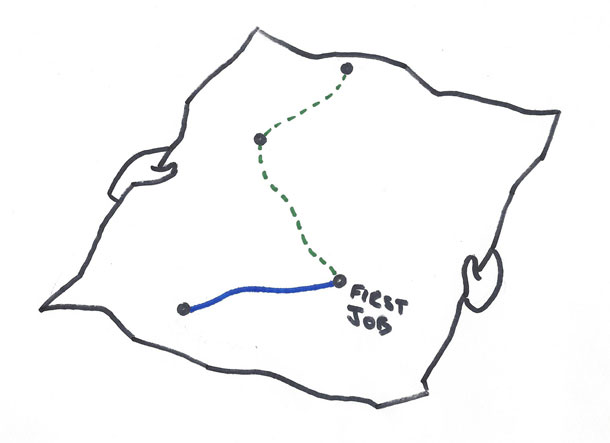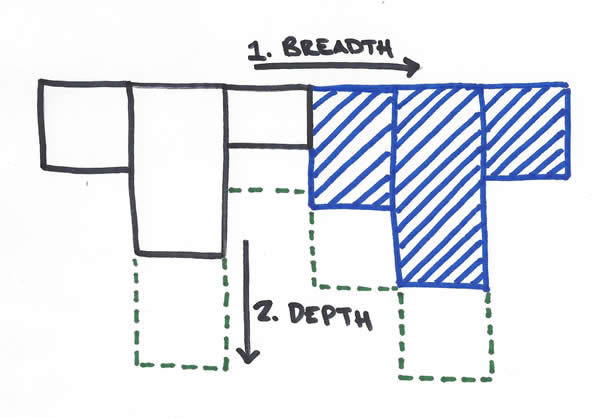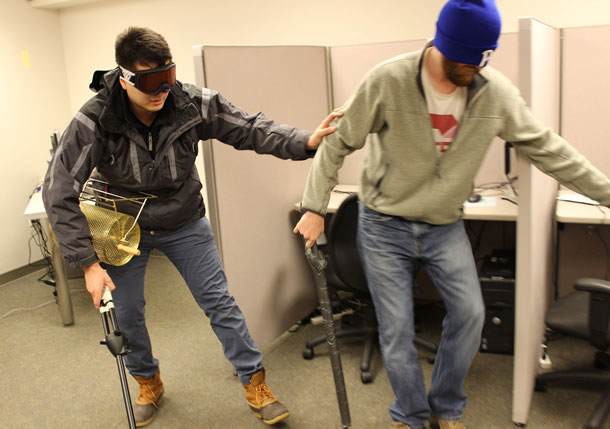For students interested in a user experience career, finding a design job may seem straightforward. Many jobs require specific skills and deliverables, which can simply be a matter of learning a method or tool. Given the financial investment required for education, many students typically focus on the job they will take immediately after graduation.
However, technology, aesthetic trends, prototyping tools, and clients are constantly changing. As resolute as the various “Top 10” lists of Design Do’s and Don’ts may seem, the reality is that even a seasoned design practitioner may not know where the field of user experience will land ten years from now (see Figure 1). Anticipating trends in the field is challenging for experienced design practitioners and even harder for students who don’t have a broad understanding of the field.
There is tension between balancing the skills, methods, and tools needed here in the present with those of the future. As a result, design education becomes a moving target—both for students as well as educators.

When considering a design education, students may consider the following questions:
- What part of the product development process do I want to be involved in?
- What kinds of hard and soft skills does this require?
- What deliverables or outcomes do I want to be responsible for?
- Do I see myself playing this same role five or ten years from now?
Conversely, user experience education programs are charged with fitting into an ever-changing field and addressing the following questions:
- How do we ensure our graduates stay relevant long after school?
- How can a design education deliver value over time?
- How do we give students tactical skills to be competitive when looking for that critical first job while still setting them up for a long-term, meaningful career trajectory?
For those students that take the long view, an education that remains relevant and supports career growth becomes paramount. Likewise, many design schools recognize that tools, methods, and clients will change—it is only by instilling flexibility that the degree can provide long-term value.
This past spring and summer, we (Zack as project lead and Laura as faculty advisor) partnered with Draper Laboratory to enhance situational awareness for first responders. This wasn’t the standard web or mobile application project and it challenged us to be flexible throughout and adapt at every turn. Using the project as an example, we will show how design programs can ensure their graduates are prepared for changes in the field by teaching students to be comfortable with uncertainty and adaptable in their process.
Experiment with Specialization
Potential students often only have a loose understanding of the many ways “user experience design” is practiced. When the design process is unpacked and the breadth of specialties is revealed, students need to place themselves within options that they didn’t realize existed (see Figure 2).

This isn’t necessarily a bad thing, as roles and titles in industry are themselves in flux. A design education should understand that students might not know all of the specialty areas, and give students space to experiment with different roles, activities, and types of problems to solve. Finding the right role becomes its own design challenge, where students and educators work together to uncover an ideal career path.
Students often focus on the short-term question of, “What do I need to get a job?” This presupposes that students know what type of job they want. More importantly, students need to answer, “What do I enjoy and how will my work provide recognizable value?” While “UX designer” means entirely different things from one company to the next, students can instead define what activities are meaningful to them and build out their ideal role responsibilities before focusing on a title.
Most likely, students will have to play a variety of roles in their career. By seeing how their ideal role fits into the UX landscape, they have the opportunity to drive change in the industry. Here students again can fall back upon flexibility, working within existing job requirements while building a career that pushes the boundaries of current design patterns, practices, and methods.
Our project with Draper was real work for a real client, yet we didn’t want to lose sight of the project as a learning experience. At the beginning, each member of our team picked a role that was new to them, providing them with nine months to experience the responsibilities of a new specialization. By deliberately placing ourselves into new roles, we each got a better idea of what mix of roles and responsibilities we want out of our jobs in industry.
Clearly Articulate Problems
User experience design is like detective work—the real problem is rarely visible on the surface. Great designers understand that a key responsibility is to clearly define what the problems are before prematurely jumping to solutions. Well-functioning teams require a shared understanding of the problem. Otherwise, they may be pulled in multiple directions, or worse, find themselves directionless.
It’s common to set the stage for design by better understanding the different stakeholders, end users, and customers, often via interviews and observational research. Through these efforts a team can better answer, “What are we solving for? Who is affected and why? How will this move us forward?”
Moreover, learning to define problems isn’t just a prerequisite for finding the right solution; it’s also an integral part of persuasion. If design students can initially build consensus about what they are solving for, they can then ensure that their ideas will resonate well with business, technology, and other stakeholders, not just other designers.
As we figured out how to build a solution for first responders, the radio repeatedly came up as a bottleneck. However, it wasn’t enough for us to simply declare that the radio was broken and proceed to fixing it from there. As a team, we modeled how communication flows between the emergency scene and the response team with individual responders at the center. Breaking out the different uses for the radio helped us see how communication outpaced the cognitive capacity of responders and where we could make a meaningful impact.
Embrace Principles Over Rules
While students may use an academic program as a testing ground for different specialty areas, they also experientially discover the timeless patterns and themes woven throughout design. Ideally, they learn when the “textbook” design processes and methods aren’t working and how to adapt when dealing with new and emerging design problems.
Design students often crave rules, looking for the formula to success. While giving hard and fast rules is a useful learning support, design schools need to emphasize skepticism and critical thought and discourage dogma. There are aesthetic trends and best practices in design that students need to be aware of, but there are no sacred cows. Every design project has its unique differences and obstacles. Design programs need to teach students the patterns and methods used for the archetypal project, but they also need to teach students to be responsive to each project’s differences.
The first part of successful design is understanding the context in which problems are embedded, gathering meaningful data, and making sense of it. This is often tackled through contextual inquiry. Traditional contextual inquiry emphasizes getting to know the users by “apprenticing” with them. In our project, however, because of the unpredictability and danger of emergency scenes, truly understanding first responders precluded contextual inquiry in the traditional sense.
We opted to break our domain research into two threads: understanding the responders’ day-to-day life through ride-alongs, and using directed storytelling to hear what it’s like to be in an emergency situation. This helped us get a baseline understanding of how first response works, but we were still arms-length from first response, looking in rather than experiencing what it felt to be inside of a burning building.
At the urging of our faculty advisors, students dressed up in mock firefighter gear and searched rooms to more holistically understand emergency situations. With the advice of firefighters, we did jumping jacks while wearing heavy jackets to simulate heat and adrenaline and intentionally blinded ourselves to simulate the impaired visibility of smoky rooms (see Figure 3).

Getting out of our heads and into the shoes of responders helped us experience the physical and cognitive pressures our prototype would have to function under further down the road. Without this deeper understanding and experimenting with novel research methods, we might have built something that looked good on paper but failed during user testing, or worse, in actual emergencies.
Encouraging students to tailor their process to the needs of the project, rather than fixate on rules, gives them the freedom to see just how far they can push. It allows them to focus on their ideas, teaching them that they are the drivers of their own work. Focusing on intrinsic motivation over extrinsic motivation sparks the hunger for students to teach themselves, a learning that will last longer than any design program.
Match Processes to Problems
Often designers gravitate toward the ubiquitous sticky note to make sense of the information gathered during research. Sticky notes are flexibility incarnate, endlessly movable, allowing designers to find patterns through constant shuffling of data. This isn’t to say, however, that there haven’t been attempts to lay out a “right” way to use the colored, semi-adhesive pieces of paper we know and love.
Affinity diagrams are one of the most common applications for sticky notes, a structured process of successive clustering used to make sense of large amounts of user observation. In Karen Holtzblatt’s contextual design method, individual notes are mixed up and then clustered in a marathon effort spanning one or two days while things are fresh. Follow her rules for making an affinity diagram and you’ll likely come out with new insights into your data.
Again, more important than the rules, however, is the principle at work: induction. Affinity diagrams work because new structures are built out of unstructured data. At the same time, the lack of initial structure can make the process arduous and frustrating—trying to remember where you put that one sticky note when you have 1,000 notes usually results in more time looking for a single puzzle piece rather than building new understanding.
In our project for Draper, we chose to prioritize sense-making over strict adherence to the rules, pre-structuring our data and breaking it out into four stages of scene progression. By focusing on what we wanted to accomplish with our affinity diagram and the principles that make it work, we were able to build a model that gave us a clearer understanding of the problem and better see how a solution could have an impact on information flows in emergency response.
Push Solution Boundaries
At each stage of the design process, students need to learn to ask, “Why?” Design education cannot focus only on how to do different methods. Knowing how to perform an A/B test is not useful if you do not know why you would use one. Paper prototyping may not be useful if you’re designing an audio interface. Students should come out of a design program being able to identify a range of methods available to them at each stage of a project, but they also need to be able to strategically string these together and see how each piece fits together as a whole.
To accomplish this, design programs should teach students to critically evaluate their methods and identify their strengths and weaknesses. It’s not hard to find conflicting advice on methods: Kim Goodwin’s advice on personas in Designing for the Digital Age differs radically from Paul Farino’s advice on using archetypes. Both give form to users, but how can students make sense of the benefits of one over the other?
Much like design problems themselves, methods require skepticism and become much more useful when the underlying reasoning is understood. Ultimately, it may be that the student needs to build his or her own methods and tools, and this can only happen when students ask, “What do I want to get out of my process?” before jumping to a particular tool or methodology.
In our case, we hit the limits of existing prototyping tools early on in our project. Most prototyping tools are geared toward designing the visual aspects of web and mobile applications. There are not yet pre-built tools for quickly prototyping heads-up displays and audio interfaces. Our project team jumped to code quicker than expected, building a virtual environment in Unity to simulate location data and immersive data presentation (see Figure 4). While the lack of prototyping tools was an obstacle, it was also an opportunity to rethink our approach to the problem and push the boundaries of user experience design by building our own prototyping platform. As wearable and ubiquitous devices become more common, learning how to work outside of the limits of existing design tools will be an invaluable skill for students.

Communicate Effectively
Understanding the why of the design process is critical for communicating it to others and getting buy-in. As new industries begin trying to understand how design can be integrated into their work, design students are increasingly required to also be design educators. Agencies such as Cooper are even starting to offer design training as a core offering. Beyond the end result, students need to be able to communicate the value of the process. Not just the general value of iterative design, though, but how the specific process used for a given project resulted in something that serves the client’s needs.
Core to this is being able to communicate the value of the design process as well as the design decisions made to a diverse array of stakeholders. As Mike Monteiro said at IxDA 2015, “Selling is a core design skill.” It’s critical that students learn not just how to design well, but also learn to communicate how robust design work serves the needs of larger business objectives.”
Working with Draper, the heads-up display and 3D-audio prototype we built helps them explore possible solutions for situational awareness. Possibly more valuable, though, are the cost savings from testing within our modular virtual environment before spending money on a full-blown field test. In the end, a student’s ability to communicate with non-designers and effect change within a larger organization is worth more than the small details that will only be noticed by other designers.
Conclusion
Students are often unsure how to pick the right educational path, especially given the pace of change within industry. In order to provide long-term value to students, design programs should emphasize flexibility: encouraging students to experiment with different design roles, focusing on principles over rules, and teaching students to think critically about their work in a way that they can articulate to themselves and others. Flexible students aren’t just prepared for the user experience industry as it stands now, they are prepared for inevitable shifts in the field as design pushes ever outward into new problems and businesses.
